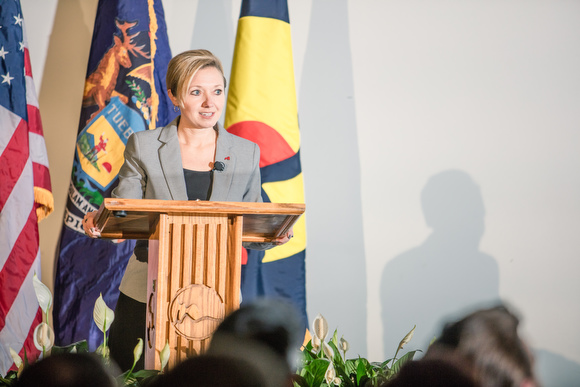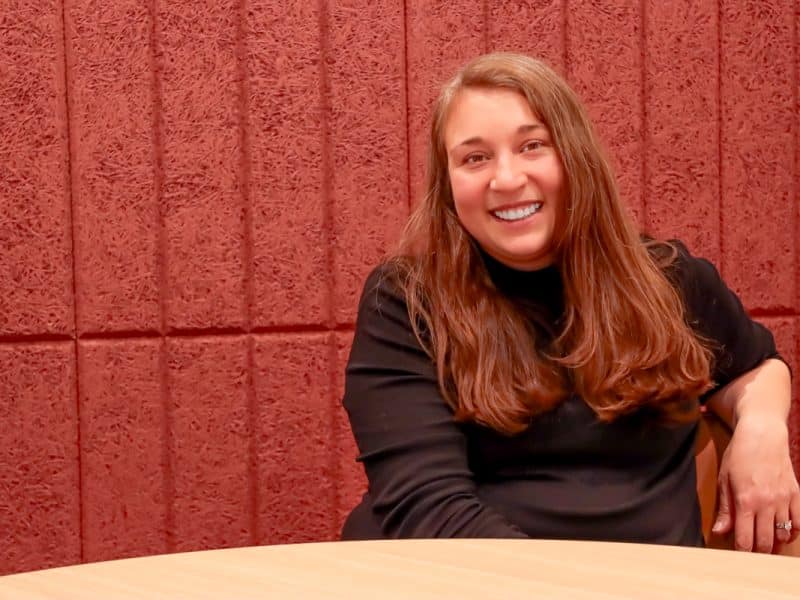The State of the City: Mayor Bliss focuses on racial disparities, affordable housing & more
Mayor Rosalynn Bliss, the first woman to be elected to Grand Rapids' highest office, details plans to tackle racism, create more affordable housing and parks, increase support for neighborhoods and minority-owned businesses, and improve relations with police in her first State of the City address.

Standing beneath the soaring ceiling of a former ballroom in Heartside’s historic Harris building, Grand Rapids Mayor Rosalynn Bliss, the first woman to ever be elected to the city’s highest office, takes a sip of water and waits for the clapping to die down after she calls for an end to chronic homelessness. In a night characterized by applause from Grand Rapidians — business owners and social justice advocates and environmentalists and many others perched on a sea of folding chairs — she goes on to say what seems to receive some of the loudest cheers of approval during her State of the City address Tuesday evening.
“We must confront a difficult issue that has grown to an unacceptable proportion in our city — that is the issue of racial disparities,” says Bliss, who took office in January, after representing the city’s 2nd Ward for a decade. “The data is striking: the typical African American household in Grand Rapids earns less than half of what the typical white household does; 42 percent of African Americans in our city live in poverty — almost four times the rate for the Caucasian population. Infant mortality for African Americans is almost three times as high. Hispanics are not faring well, either, with 35 percent in Grand Rapids living in poverty and unemployment at 27 percent.
“When you consider the reality that these statistics represent, it is no wonder many in our city feel a sense of hopelessness for themselves and for their children, Bliss continues. “As your mayor, these issues will not go ignored.”
It is this declaration of attention to systemic racism that receives numerous shouts of approval from the audience, and the call for change is one of the predominant themes that runs throughout the evening. Yes, Bliss says, Grand Rapids has plenty to celebrate, but her focus is on that which she says must transform in order for the city to retain, and support, a diverse population that needs more affordable housing and parks, increased support for minority-owned businesses, better relations with police, and more aid for neighborhoods.
And, of course, a need to tackle pervasive racial injustice.
These are big issues — and ones that have marred communities for a long time. So, how is it that Bliss will be able to address such deep-rooted problems?
“It starts with how our city government looks and thinks,” the mayor says. “City staff will begin to undergo implicit bias training. We have to learn to honestly assess our own biases, and to know to what extent they have resulted in denying opportunities for others. Biases result in limiting access to childcare, transportation, housing, healthcare, job opportunities, and equitable wages. I urge businesses and organizations across our community to consider similar training steps, if they have not already. We must all be committed to change and improvement.”
In addition to concrete change, such as working towards improved community relations with the Grand Rapids Police Department, additional support for minority-owned businesses, access to affordable housing, and more, Bliss says dialogue on racial disparities in the city are crucial and, in light of that, is launching the “Mayor’s Book of the Year.”
“I can think of no better book than ‘A City Within a City: The Black Freedom Struggle in Grand Rapids, Michigan’ by Todd E. Robinson,” Bliss says of the tome that focuses on the history of Grand Rapids’ African Americans fight against racism in housing, education, the economy, and more.

The book “provides a historical framework to help us learn from our past and appreciate the context of our current state — and it provides hope for the future,” she adds and notes she will host a community forum on the book this coming summer.
In addition to all of this, Bliss says she’ll work with community leaders to create a “strategic action plan to eliminate racial disparities.”
“By working together, we can establish a collective goal, and we can create lasting, positive change,” she says.
This call for transformation is, of course, not surprising: Bliss has long championed these ideas and campaigned on promises of pushing Grand Rapids to be a better, more inclusive place. However, it was in Tuesday evening’s speech that Grand Rapidians got a very clear glimpse as to the policies that will shape the Bliss administration.
Access to affordable housing
“Housing in our city is a hot issue with a lot of different perspectives chiming in,” Bliss says. “This is my perspective: I grew up in a large family of 10. My dad was a brick mason who didn’t graduate from high school. Life wasn’t easy for our family — there were times when the heat was shut off, and I would huddle with my brothers under blankets with a hair dryer to stay warm.”
It was moments like these, the mayor continues, that inspired her “to work hard,” put herself through college, and live in a small Eastown apartment in order to save for a house.
“I never want to see the day that somebody, no matter what their own personal journey is, cannot afford to make a life in our city,” she says. “It was with a deep sense of pride that I was able to buy my home. I want this same opportunity for others.”
However, as Bliss concedes, this is an opportunity that many in Grand Rapids cannot access. Residents have, increasingly, been unable to afford housing in the city, for a myriad reasons that the city’s “Great Housing Strategies,” a multi-tiered plan to address housing needs in the Grand Rapids, points out: limited access to credit following the 2008 financial collapse and foreclosure crisis, spiking rents, a plummeting rental vacancy rate (which hovers around 1.6 percent and is the lowest in the country), an increasing number of college students and limited school housing, and a slow economy and stagnant wages, among other reasons. People not only are facing being unable to buy their own home; some are being entirely displaced in rapidly gentrifying areas.
Praising the Great Housing Strategy’s focus on mixed-income developments, creating live-work spaces, building workforce housing, and implementing eviction prevention ideas, Bliss goes on to say that “it is time to create a structure to move this work forward.
“I ask the City Commission to join me in the establishment of a housing fund that can be built as a stable and effective way to help ensure long-term financing for affordable housing,” she says.

A greener, more sustainable Grand Rapids
Saying that the Grand River must not be neglected, Bliss emphasizes the recently adopted GR Forward Plan, the city’s first new downtown master plan in 22 years that calls for reshaping the downtown area and Grand River corridor.
“Imagine rowing alongside Riverside Park, canoeing or kayaking through the city and the eventual capacity to ride your bike on a 10-mile urban trail along the river, from Riverside Park to Millennium Park and beyond,” she says, adding that these are all possibilities under the GR Forward Plan.
In addition to the redevelopment of the river area, the mayor sets a series of sustainability goals, including: Grand Rapids getting 100 percent of its energy from renewable sources by 2025, increasing recycling, reaching 100 miles of bikes lanes throughout the city by 2017 (“Grand Rapids has one of the highest bike crash rates in our state,” Bliss notes), grow the city’s urban tree canopy to 40 percent, and ensure there is a park within walking distance of every child in our community.
Increased support for minority-owned businesses
A number of business leaders who attended the State of the City, including Javier Olvera, President and Owner of Supermercado Mexico, a successful collection of three supermarkets and, most recently, a bakery, and Jamiel Robinson, the founder of Grand Rapids Area Black Businesses, are lauding Bliss’s call to “enhance minority-owned businesses.”
“I support the creation of cultural districts in key corridors, such as Grandville Avenue and Southtown,” Bliss says. “I am looking at ways to reform our local policies to support entrepreneurs. As one example, I will ask key stakeholders to assist in creating a series of community-supported recommendations, along with amendments to our food truck ordinance to expand designated areas, hours of operations and streamline licensing.”
Olvera says he would like to see the administration connect entrepreneurs and business owners with already existing groups that support minority businesses, such as the Michigan Small Business Development Center.
Robinson stresses that he wants to see the mayor continue to focus on this goal.
“Keep these conversations in front of people’s faces,” he says. “Don’t disappear from public sight.”
Improved relations among the community and the Grand Rapids Police Department
To address strained relationships between residents, particularly in minority communities, and the GRPD, Bliss says the city is “actively working on full implementation” of the Community and Police Relations Recommendations, which was drafted about one year ago and has since been adopted by the City Commission.
As part of this plan, police leaders, including Chief David Rahinsky, have been meeting with residents to address concerns, and Bliss notes the city is adding more community police officers, with the hope that will help to quell tensions and build better relationships.
“We want all citizens to see every police officer as their community officer,” Bliss says, adding that the city is “enhancing training and providing cultural competence and implicit bias training for all officers.”
Other steps being taken include: outfitting police officers with body cameras, which will be fully implemented by the end of February, and analyzing, and publicly reporting, arrest and traffic stop data. Officer-involved shootings are being investigated by an outside police agency.
The path to stronger neighborhoods
“As much as we are defined by our city, neighborhoods further define and unite us,” Bliss says before detailing an “individualized approach to supporting neighborhoods that respects what is unique about each and every one.” Such an approach includes the addition of a Neighborhood Coordinator at the city (Stacy Stout, the program manager at the W.K. Kellogg Foundation and the co-founder of the Latina Network of West Michigan recently began this job).
Additionally, the mayor says she’s urging the City Commission to allocate more funding for neighborhood projects through a “Neighborhood Matching Fund.” Such a fund would allow the city to “match money raised within neighborhoods for improvement initiatives and projects,” Bliss says.
“These mini-grants could be used for planning, events, sprucing up buildings, building community gardens, creating public art, beautifying right of ways, and much more.”
Bliss’s other efforts to help neighborhoods include: supporting the 2nd Annual Neighborhood Summit (which will take place on March 11 and informs the city on the changing needs of communities), strengthening the city’s youth employment program to create more jobs for young people, and calling on her colleagues to pass an ordinance to “address blighted, vacant properties — and hold accountable those responsible for properties that are being ignored.”
Meet with Mayor Bliss to discuss the State of the City
Following Tuesday’s address, the mayor is inviting all members of the public to meet with her about the goals outlined in the State of the City. She will hold a series of “Neighborhood Meetup” events, one in each city ward, next week.
The meetings will be held:
- Monday, Feb. 8 at Shawmut Hills Elementary (2550 Burritt St. NW)
- Wednesday, Feb. 10 at Gerald R. Ford Academy (857 Madison Ave. SE)
- Thursday, Feb. 11 at Palmer Elementary (309 Palmer St. NE)
Those who are unable to attend may email their comments or questions to Mayor@grcity.us.
Photography by Adam Bird









